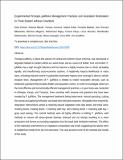| dc.description.abstract | Prosopis juliflora, a native tree species of Central and northern South America, was introduced in degraded habitats in Eastern Africa as a wind break, and as a source of fodder, fuel, and timber. P. juliflora has a high drought tolerance and has become a highly invasive tree or shrub, spreading rapidly, and transforming socio-economic systems. It negatively impacts livelihoods in many ways, including reduced income in pastoralist-dominated regions once coverage is above a certain invasion level. Management of P. juliflora is needed to restore ecosystem services, such as biodiverse grassland that provides fodder and sequesters carbon. In order to investigate which are the most effective and economically efficient management practices, a 3-year study was conducted in Ethiopia, Kenya, and Tanzania, three countries with savanna and grassland that have been invaded by P. juliflora. The management treatments being tested were: manual uprooting; cutting the stumps and applying herbicide; and basal bark herbicide treatment. Alongside these treatments, restoration interventions aimed at restoring natural vegetation were also tested, and these were: creating divots; creating divots + mulching with hay; and creating divots + mulching with hay + grass seed sowing. The control methods were all highly effective in killing P. juliflora, with methods to remove all above-ground biomass (manual and cut stump) resulting in a more productive and diverse surrounding vegetation than the basal bark herbicide treatment. The effect of the restoration interventions on vegetation composition was small, suggesting that species were re-established mostly from the soil seed bank. This case presents some of the methods and results of the study. | en_US |

